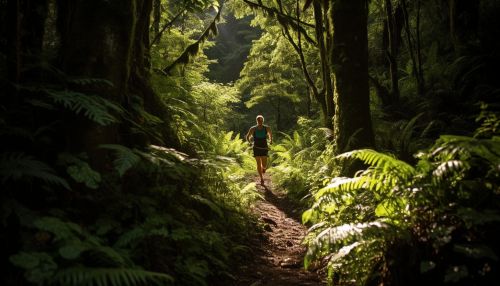Trail running
Overview
Trail running is a sport-activity which combines running, and, where there are significant gradients, hiking, that is run "on any unpaved surface". It is similar to both mountain and fell running (also known as hill running). Mountain running may, however, include paved sections. Trail running normally takes place in warm climates, or on good paths, or tracks which are relatively easy to follow, and does not necessarily involve the significant amounts of ascent, or need for navigating skills, normal in fell running. Unlike road running and track running it generally takes place on hiking trails, often in mountainous terrain, where there can be much larger ascents and descents. It is difficult to definitively distinguish trail running from cross country running. In general, however, cross country is an IAAF governed discipline that is typically raced over shorter distances, whereas trail running is loosely governed, and run over longer routes.
History
Trail running has a long history stretching back to the ancient times, and it is likely that man has been running on trails for millions of years. The sport has its roots in early human necessity – it was important for man to be able to run long distances in order to hunt for food. The first competitive running events took place in the early 19th century, with trail running becoming a defined discipline in the latter part of the 20th century.
Equipment
Trail running is a unique sport that requires special equipment to ensure safety and comfort. The most important piece of equipment for trail running is the shoes. Trail running shoes are designed with a more aggressive tread pattern to provide more traction and stability on uneven terrain. They also often have features like toe guards and waterproof materials to protect the feet from trail hazards. Other important equipment for trail running includes hydration packs, nutrition, and safety gear like headlamps and first aid kits.


Training
Training for trail running is similar to training for road running, but with some key differences. Because trail running often involves more challenging terrain and conditions, it requires a different approach to training. This includes incorporating more hill work and strength training into your routine, as well as working on skills like navigation and trail reading. It's also important to train in similar conditions to what you'll face in your target race, so if you're training for a trail race that involves a lot of elevation gain and technical terrain, you'll want to include plenty of hilly, technical trails in your training.
Techniques
There are several key techniques that are unique to trail running. These include learning how to navigate and read the trail, how to run on different types of terrain, how to manage your pace and energy, and how to handle the mental challenges of trail running. Mastering these techniques can help you become a more efficient and successful trail runner.
Competitions
There are many trail running competitions around the world, ranging from short, local races to ultra marathons that cover hundreds of miles. These races often take place in beautiful, remote locations and offer a unique challenge for runners. Some of the most famous trail running races include the Western States 100, the Ultra-Trail du Mont-Blanc, and the Hardrock 100.
Health and Safety
Trail running, like any sport, carries some risks. These include the risk of injury from falls, the risk of getting lost, and the risk of encountering dangerous wildlife. It's important for trail runners to take precautions to mitigate these risks, such as wearing appropriate gear, carrying a map and compass, and being aware of their surroundings.
